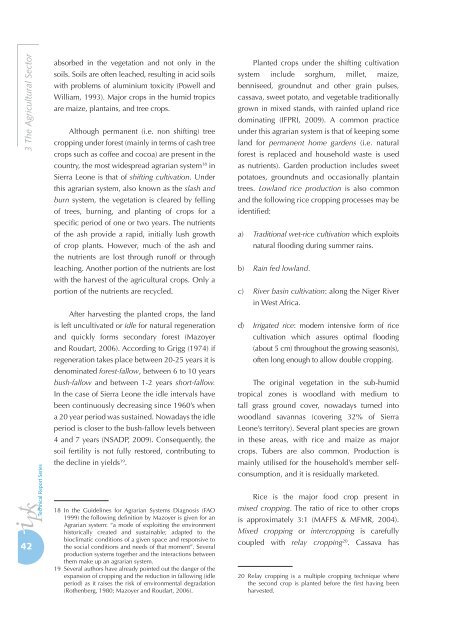SIERRA LEONE maq 4ª.indd - agrilife - Europa
SIERRA LEONE maq 4ª.indd - agrilife - Europa
SIERRA LEONE maq 4ª.indd - agrilife - Europa
Create successful ePaper yourself
Turn your PDF publications into a flip-book with our unique Google optimized e-Paper software.
3 The Agricultural Sector<br />
42<br />
absorbed in the vegetation and not only in the<br />
soils. Soils are often leached, resulting in acid soils<br />
with problems of aluminium toxicity (Powell and<br />
William, 1993). Major crops in the humid tropics<br />
are maize, plantains, and tree crops.<br />
Although permanent (i.e. non shifting) tree<br />
cropping under forest (mainly in terms of cash tree<br />
crops such as coffee and cocoa) are present in the<br />
country, the most widespread agrarian system18 in<br />
Sierra Leone is that of shifting cultivation. Under<br />
this agrarian system, also known as the slash and<br />
burn system, the vegetation is cleared by felling<br />
of trees, burning, and planting of crops for a<br />
specific period of one or two years. The nutrients<br />
of the ash provide a rapid, initially lush growth<br />
of crop plants. However, much of the ash and<br />
the nutrients are lost through runoff or through<br />
leaching. Another portion of the nutrients are lost<br />
with the harvest of the agricultural crops. Only a<br />
portion of the nutrients are recycled.<br />
After harvesting the planted crops, the land<br />
is left uncultivated or idle for natural regeneration<br />
and quickly forms secondary forest (Mazoyer<br />
and Roudart, 2006). According to Grigg (1974) if<br />
regeneration takes place between 20-25 years it is<br />
denominated forest-fallow, between 6 to 10 years<br />
bush-fallow and between 1-2 years short-fallow.<br />
In the case of Sierra Leone the idle intervals have<br />
been continuously decreasing since 1960’s when<br />
a 20 year period was sustained. Nowadays the idle<br />
period is closer to the bush-fallow levels between<br />
4 and 7 years (NSADP, 2009). Consequently, the<br />
soil fertility is not fully restored, contributing to<br />
the decline in yields19 .<br />
18 In the Guidelines for Agrarian Systems Diagnosis (FAO<br />
1999) the following definition by Mazoyer is given for an<br />
Agrarian system: “a mode of exploiting the environment<br />
historically created and sustainable; adapted to the<br />
bioclimatic conditions of a given space and responsive to<br />
the social conditions and needs of that moment”. Several<br />
production systems together and the interactions between<br />
them make up an agrarian system.<br />
19 Several authors have already pointed out the danger of the<br />
expansion of cropping and the reduction in fallowing (idle<br />
period) as it raises the risk of environmental degradation<br />
(Rothenberg, 1980; Mazoyer and Roudart, 2006).<br />
Planted crops under the shifting cultivation<br />
system include sorghum, millet, maize,<br />
benniseed, groundnut and other grain pulses,<br />
cassava, sweet potato, and vegetable traditionally<br />
grown in mixed stands, with rainfed upland rice<br />
dominating (IFPRI, 2009). A common practice<br />
under this agrarian system is that of keeping some<br />
land for permanent home gardens (i.e. natural<br />
forest is replaced and household waste is used<br />
as nutrients). Garden production includes sweet<br />
potatoes, groundnuts and occasionally plantain<br />
trees. Lowland rice production is also common<br />
and the following rice cropping processes may be<br />
identified:<br />
a) Traditional wet-rice cultivation which exploits<br />
natural flooding during summer rains.<br />
b) Rain fed lowland.<br />
c) River basin cultivation: along the Niger River<br />
in West Africa.<br />
d) Irrigated rice: modern intensive form of rice<br />
cultivation which assures optimal flooding<br />
(about 5 cm) throughout the growing season(s),<br />
often long enough to allow double cropping.<br />
The original vegetation in the sub-humid<br />
tropical zones is woodland with medium to<br />
tall grass ground cover, nowadays turned into<br />
woodland savannas (covering 32% of Sierra<br />
Leone’s territory). Several plant species are grown<br />
in these areas, with rice and maize as major<br />
crops. Tubers are also common. Production is<br />
mainly utilised for the household’s member selfconsumption,<br />
and it is residually marketed.<br />
Rice is the major food crop present in<br />
mixed cropping. The ratio of rice to other crops<br />
is approximately 3:1 (MAFFS & MFMR, 2004).<br />
Mixed cropping or intercropping is carefully<br />
coupled with relay cropping20 . Cassava has<br />
20 Relay cropping is a multiple cropping technique where<br />
the second crop is planted before the first having been<br />
harvested.
















